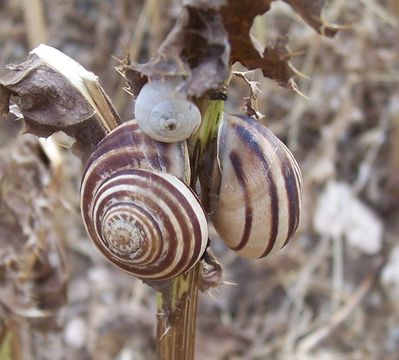Eobania vermiculata
Chocolate-band Snail
Synonyms: Helix vermiculata, Helix linusae
Class: Gastropoda
Order: Stylommatophora
Family: Helicidae

Photographer: Luigi Rignanese
Source: http://eol.org/data_objects/13260746
Description
Eobania vermiculata is an air-breathing terrestrial snail. The color of the shell is variable, ranging from whitish to greenish yellow, often with multiple color bands or spots; the lower side frequently has two brown bands and is whitish in color between lowest band and umbilicus. The shell has 4-4.5 whorls. The width of the shell is 22–32 mm and the height is 14–24 mm. The body of the snail is gray on the dorsal side and yellowish on the ventral side.
Ecological Threat: With Eobania vermiculata having a long lifespan (between 2-5 years), an established population has opportunity to continuously grow. The long lifespan could make this species grow from a minor concern to a major concern for native gastropod species, garden plants and agricultural crops alike. Vineyards are very threatened with Eobania vermiculata being observed on grape plants in their native range. That makes this snail a direct threat to California and Texas as vineyards are extremely prevalent in both. Even though it is not considered a pest in its native habitat, with no natural predators present, the appearance and establishment of the chocolate-band snail could pose as a threat to native snail populations.
Biology: Around 70 eggs per snail are laid with the size of the egg being 4.1 × 3 mm. Juveniles hatch shortly after and grow about 12–13 mm in diameter per year for 2 years. Maturity is reached after 2 years when the diameter reaches 25 mm. Snails reach 29–30 mm diameter in May/June of the second year, reaching a maximum diameter may take 5 years or more, but mortality increases greatly after 2 years.
History: Like other terrestrial snails Eobania vermiculata is used for food in the native lands of Europe. This is also a major factor to the spread of this snail, along with the fact it is used in the pet trade also. It has been accidentally introduced into Louisiana and Texas but is thought to be a minor threat to agriculture. However, since this snail has observed to feed on vineyards and other agricultural crops that grow within these 2 states, the threat of the chocolate-band snail may be larger than previously thought.
U.S. Habitat: In a broad variety of habitats, usually in dry vegetation, mainly in coastal vicinity, also in agricultural crops and vineyards.
Distribution
Native Origin: Spain, Ukraine and Greece
U.S. Present: CA, LA and TX
Management
This species is considered to represent a potentially serious threat as a pest, an invasive species which could negatively affect agriculture, natural ecosystems, human health or commerce. Therefore it has been suggested that this species be given top national quarantine significance in the United States.
References
Heller J. 2001. Life History Strategies. In: Barker G. M. (ed.) The biology of terrestrial molluscs. CABI Publishing, Oxon, UK
Notton D. 2006. Eobania vermiculata in the UK. Mollusc World 11:6.
Internet References
http://www.invasive.org/browse/detail.cfm?imgnum=5433342
http://www.animalbase.uni-goettingen.de/zooweb/servlet/AnimalBase/home/species?id=1367
 Texas Invasive Species Institute
Texas Invasive Species Institute